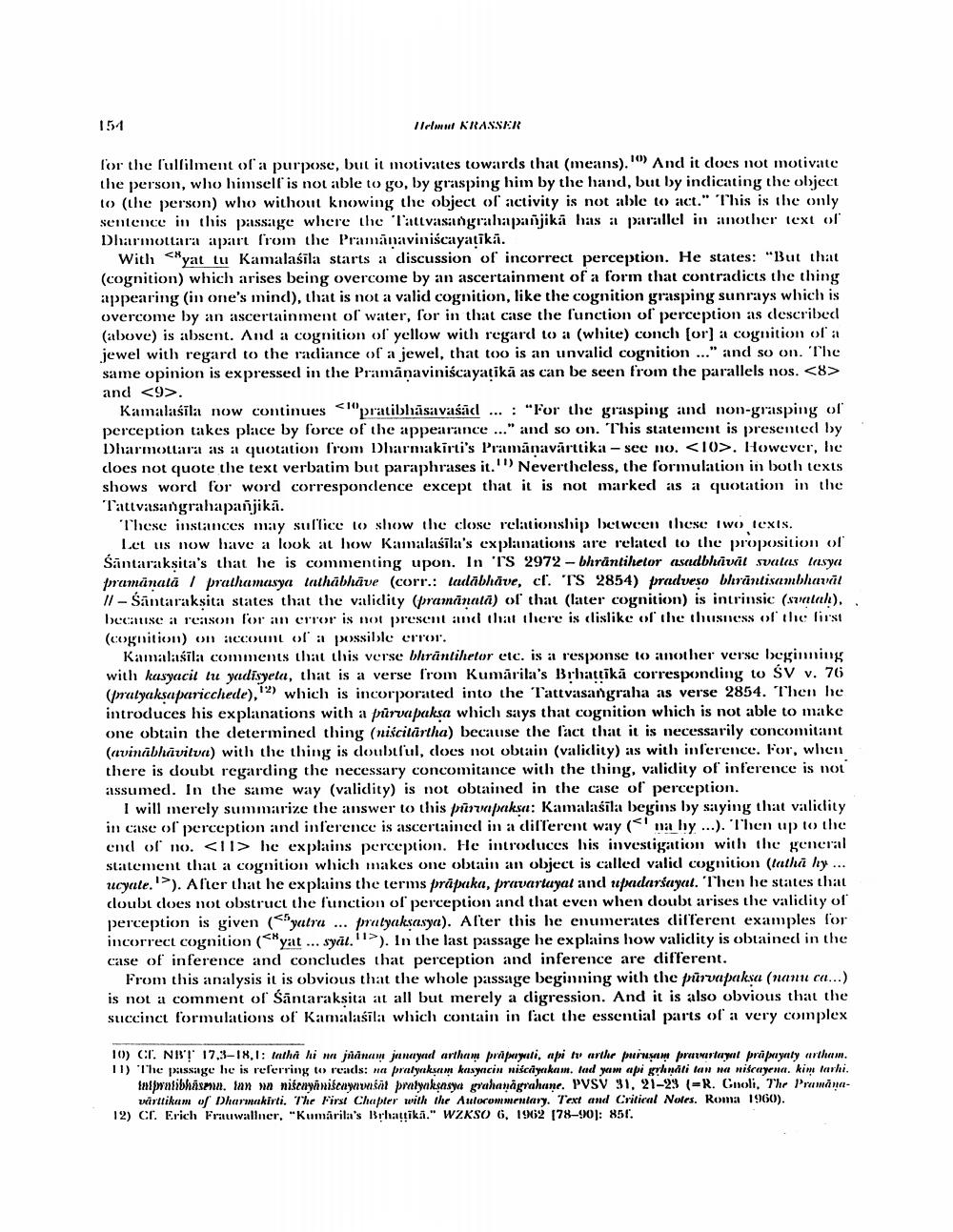Book Title: On Relationship Between Dharmottara Santaraksita And Kamalasila Author(s): Helmut Krasser Publisher: Helmut Krasser View full book textPage 4
________________ 151 IIrlmut KRASSER for the l'ulfilment of a purpose, but it motivates towards that means)."') And it does not motivate the person, who himself is not able to go, by grasping him by the hand, but by indicating the object to the person) who without knowing the object of activity is not able to act." This is the only sentence in this passage where the 'Tattvasangrahapanjika has at parallel in another text of Dharmottara apart from the Pramämaviniscayatikā. With <yat tu Kamalasila starts a discussion of incorrect perception. He states: "But that (cognition) which arises being overcome by an ascertainment of a form that contradicts the thing appearing in one's mind), that is not a valid cognition, like the cognition grasping sunrays which is overcome by an ascertainment of water, for in that case the function of perception as described (above) is absent. And a cognition of yellow with regard to a (white) conch (or) a cognition of a jewel with regard to the radiance of a jewel, that too is an unvalid cognition ..." and so on. The same opinion is expressed in the Pramanaviniscayatika as can be seen from the parallels nos. <8> and <9> Kamalaśīla now continues <1"pratibhāsavaśād ... : "For the grasping and non-grasping of perception takes place by force of the appearance ..." and so on. This statement is presented by Dharmottara as a quotation from Dharmakirti's Pramanavarttika - see no. <10>. However, he cloes not quote the text verbatim but paraphrases it.") Nevertheless, the formulation in both texts shows word for word correspondence except that it is not marked as a quotation in the Tattvasangrahapanjikā. These instances may sullice to show the close relationship between these two texts. Let us now have a look at how Kamalasila's explanations are related to the proposition of Śäntaraksita's that he is commenting upon. In TS 2972-bhräntihelor asadbhavil svatus tasya pramanata / prathamasya tathābhäve (corr.: Ladābhāve, cl. TS 2854) pradveso bhrintisambhavil II - Säntaraksita states that the validity (pramānala) of that (later cognition) is intrinsic (salah). because a reason for an error is not present and that there is clislike of the chusness of the first (cognition) on account of possible error. Kamalasila comments that this verse bhrāntihelor etc. is a response to another verse beginning with kasyacit tu yadisyeta, that is a verse from Kumārila's Brhattikä corresponding to SV v. 76 (pratyaksaparicchede), 2) which is incorporated into the Tattvasangraha as verse 2854. Then he introduces his explanations with a pūrva paksa which says that cognition which is not able to make one obtain the determined thing (niścilārtha) because the fact that it is necessarily concomitant (avinābhāvilva) with the thing is doubtful, does not obtain (validity) as with inference. For, when there is doubt regarding the necessary concomitance with the thing, validity of inference is not assumed. In the same way (validity) is not obtained in the case of perception. I will merely summarize the answer to this pārvapaksa: Kamalasila begins by saying that validity in case ol' perception and inference is ascertained in a different way ( na hy ...). Then up to the end of no. <11> he explains perception. He introduces his investigation with the general statement that a cognition which makes one obtain an object is called valid cognition (latha hy ... ucyale.')). After that he explains the terms prāpaka, pravartayal and spadarśayal. Then he states that cloubt does not obstruct the function of perception and that even when doubt arises the validity of perception is given (Syatra ... prutyaksasya). After this he enumerates different examples for incorrect cognition (<*yat ... syail.">). In the last passage he explains how validity is obtained in the case of inference and concludes that perception and inference are different. From this analysis it is obvious that the whole passage beginning with the pūrvapaksa (nann ca...) is not a comment of Santaraksita at all but merely a digression. And it is also obvious that the succinct formulations of Kamalasila which contain in fact the essential parts of a very complex 10) CI. NIST 17.3-18.1: Intha hi un janam junayad artham prapamuli, aptarthr puimme pronuluyl prapryly artham. 11) The passage he is referring to reads: na pratyaksam kasyacin niściyekam, lad yam api gyhniti taw wa niscayena, kim tarhi. Inkppalibhasma. Inn »a niścnyiniścumsat praiyaksasya grahanågrahane. PVSV 31, 21-23 (R. Guoli, The Promāna wirttikam of Dharwakinti. The Mirst Chapter with the Aulocommentary. Text and Critical Neves. Roma 1960). 12) Cr. Erich Fritwallner. "Kumarita's Brhatikā." WZKSO 6, 1962 178-90): 856.Page Navigation
1 2 3 4 5 6 7 8
